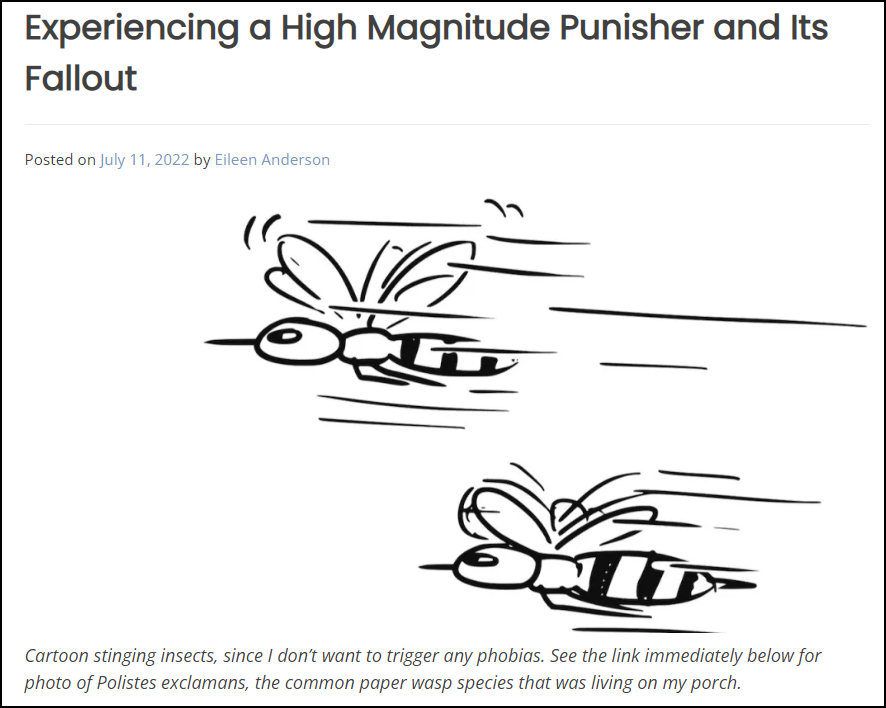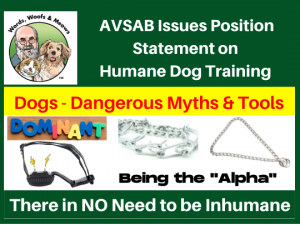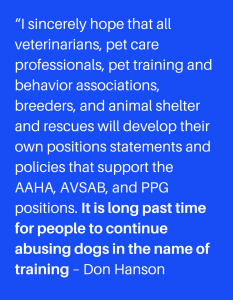< A short link to this post – http://bit.ly/WfMw-WhatShock-27JUL19 >
< Click to Listen to Podcast >
 In this episode of The Woof Meow Show from July 27th, 2019 Kate interviews Don, asking him about his article, What’s Shocking About Shock – What Science Tells Us About the Use of Shock in Dog Training, published in the July 2019 issue of BARKS from The Guild, the journal of the Pet Professional Guild (PPG).
In this episode of The Woof Meow Show from July 27th, 2019 Kate interviews Don, asking him about his article, What’s Shocking About Shock – What Science Tells Us About the Use of Shock in Dog Training, published in the July 2019 issue of BARKS from The Guild, the journal of the Pet Professional Guild (PPG).
The use of electric shock for training, containing, and caring for dogs is extremely controversial. In this podcast we examine and discuss what peer-reviewed scientific studies report about the use of shock and answer four common questions; Does electric shock hurt?, Is electric shock more efficient for training dogs than reward-based training?, Is electric shock necessary for training behaviors like snake aversion?, and Does electric shock save dogs lives? Additionally, we review the formal positions taken on the use of shock by several organizations of pet care professionals from around the globe, and also examine the countries where the use of shock has already been banned.
If you are using shock or contemplating using shock you will want to hear what science says by listening to this show/podcast; your dog’s health and welfare may depend on you understanding this controversial tool and its harmful side effects. We also recommend you also read Don’s article and all of the scientific studies that he cites in the article, all of which you can link to at Don’s blog at http://bit.ly/ShockBARK-JUL2019.
You can hear The Woof Meow Show on Z62 Retro Radio, AM620, and WKIT HD3 at 9 AM on Saturday. If you are not near a radio, listen on your computer at http://bit.ly/AM620-WZON or your smartphone or tablet with the free WZON 620 AM app. A podcast of the show is typically posted immediately after the show. You can download this show and others at http://woofmeowshow.libsyn.com/, at Don’s blog http://bit.ly/Words-Woofs-Meows and the Apple iTunes store.
< Click to Listen to Podcast >
References
American Animal Hospital Association. (2019). AAHA behavior guidelines offer solutions to managing behavior problems with your pet. Available at: http://bit.ly/AAHABhx2015
Anderson, E. (2012). What is Shock Training? – Is It Really Just A Tap? Shock Collar Training Explained. Available at: http://bit.ly/SHOCK-Anderson-WhatIsShock
Blackwell, E.J., Bolster, C., Richards, G., Loftus, B.A., & Casey, R.A. (2012). The use of electronic collars for training domestic dogs: estimated prevalence, reasons and risk factors for use, and owner perceived success as compared to other training methods. BMC Veterinary Research (8) 93. Available at: http://bit.ly/SHOCK-Blackwell-BMCVR-2012
Brewer, P. (2019). Do let the dogs out: Huge fines for pet confinement part of ACT animal welfare overhaul. Available at: http://bit.ly/2Wx0Qu8
British Columbia Society for the Prevention of Cruelty to Animals. (2019). Position Statement on Animal Training. Available at: http://bit.ly/2XEb8W2
British Small Animal Veterinary Association. (2019). Position Statement on Aversive Training Methods. Available at: http://bit.ly/2F0HdAa
British Veterinary Association. (2018). Aversive training devices for dogs. Available at: http://bit.ly/2XByUlv
Canadian Veterinary Medical Association. (2015). Humane Training Methods for Dogs – Position Statement. Available at: http://bit.ly/2KHCcQr
Department for Environment, Food and Rural Affairs. (2010). Studies to assess the effect of pet training aids, specifically remote static pulse systems, on the welfare of domestic dogs: Project Code AW1402. Available at: http://bit.ly/SHOCK-DEFRA-AW1402-2013
Department for Environment, Food and Rural Affairs. (2011). Studies to assess the effect of pet training aids, specifically remote static pulse systems, on the welfare of domestic dogs; field study of dogs in training: Project Code AW1402a. Available at: http://bit.ly/SHOCK-DEFRA-AW1402a-2013
European Society of Veterinary Clinical Ethology. (2017). ESVCE Position Statement: Electronic Training Devices. Available at: http://bit.ly/SHOCK-ESVE_Pos
Hiby, E.F., Rooney, N.J., & Bradshaw, J.W.S. (2004). Dog training methods—their use, effectiveness and interaction with behaviour and welfare. Animal Welfare (13) 63–69. Available at: http://bit.ly/SHOCK-Hiby-AnimWelfare-2004
New Zealand Veterinary Association. (2018). Use of behaviour modifying collars on dogs. Available at: http://bit.ly/2F1z6Dj
Pet Professional Guild. (2012). Guiding Principles. Available at: http://bit.ly/PPG-GuidingPrinciples
Polsky, R. (2000). Can Aggression in Dogs Be Elicited Through the Use of Electronic Pet Containment Systems? Journal of Applied Animal Welfare Science 3 (4) 345‐357. Available at: http://bit.ly/SHOCK-Polsky-JAAWS-Aggx-2000
Sandgrain Films. (2017). Shock Collar [Video File]. Available at: http://vimeo.com/235106629
Schalke, E., Stichnoth, J., & Jones‐Baade, R. (2005). Stress symptoms caused by the use of electric training collars on dogs (Canis familiaris) in everyday life situations. Current Issues and Research in Veterinary Behavioral Medicine. 5th International Veterinary Behavior Meeting. West Lafayette, Indiana: Purdue University Press, 139‐145.
Schalke, E., Stichnoth, J., Ott, S., & Jones‐Baade, R. (2007). Clinical signs caused by the use of electric training collars on dogs in everyday life situations. Applied Animal Behaviour Science 105 (4) 369‐380. Available at: http://bit.ly/SHOCK-Schalke-AABS-JUL2007
Schilder, M., & van der Borg, J. (2004). Training dogs with help of the shock collar: short and long term behavioural effects. Applied Animal Behaviour Science (85) 319–334. Available at: http://bit.ly/SHOCK-Schilder-AABS-MAR2004
Shock‐Free Coalition. (2019). Myths and Misconceptions. Available at: https://www.shockfree.org/Education/Myths-and-Misconceptions
The Kennel Club. (2018). The Kennel Club and Scottish Kennel Club Welcomes the Scottish Government’s Effective Ban on Shock Training Devices. Available at: http://bit.ly/31r1Zm7
Tudge, N.J, & Nilson, S.J. (2016). The Use of Shock in Animal Training. Available at: https://www.petprofessionalguild.com/shockcollars
Tudge, N.J, Nilson, S.J., Millikan, D.A., & Stapleton‐Frappell, L.A. (2019). Pet Training and Behavior Consulting: A Model for Raising the Bar to Protect Professionals, Pets and Their People. (n.p.): DogNostics Career Center Publishing – https://petindustryregulation.com/
Yin, S. (2011). Are Electronic Shock Collars Painful – A New Study Reveals Some Answers. Available at: http://bit.ly/SHOCK-Yin-Pain-2011
Yin, S. (2012). How Technology from 30 Years Ago is Helping Military Dogs Perform Better Now. Available at: http://bit.ly/POS-REI-SpyCats
Resources
American Animal Hospital Association (AAHA) 2015 Canine and Feline Behavior Management Guidelines: http://bit.ly/AAHABhx2015
European Society of Veterinary Clinical Ethology ‐ Position Statement on Electronic Training Devices: http://bit.ly/SHOCK-ESVE_Pos
Pet Professional Guild ‐ Rattlesnake Avoidance Training Using Force‐Free Methods [Webinar]: https://petprofessionalguild.com/event-1913569
Pet Professional Guild ‐ Member Search: http://bit.ly/PPG-Find-A-Prof
Pet Professional Guild ‐ Position on Shock Training: https://www.petprofessionalguild.com/shockcollars
Shock‐Free Coalition: https://www.shockfree.org/
Shock‐Free Coalition Pledge: https://www.shockfree.org/Pledge
Other Related Resources
Hanson, D. (2004-2018). The Unintended Consequences of Shock Collars, Available at: http://bit.ly/ShockCollars
Hanson, D. (2018) Helping Your Dog Thrive with Brambell’s Five Freedoms, Available at: Brambell’s Five Freedoms
Hanson, D. (2018, 2019). Things I Wish I Had Known…, Available at: http://bit.ly/ThingsIWishIHadKnown
Hanson, D. (2006). Green Acres’ First Statement on Being A Pet Friendly-Facility, Available at: http://bit.ly/GAKS1stPetFriendly
Hanson, D. (2006). Green Acres Kennel Shop Position Statement on Pet Friendly, Force-Free Pet Care, Available at: http://bit.ly/GAKS_Pet-Friendly
Hanson, D. (2018). The Shock-Free Coalition: What’s Next?, Don Hanson explains how to keep the momentum going once you have signed the Shock-Free Pledge, http://bit.ly/BARKS-ShockFreeMAR2018
Hanson, D. (2018) Celebrating the 1st Year of the Shock-Free Coalition – +R Rocks, Available at: http://bit.ly/Shock-FreeRocks
Podcast – The Unintended Consequences of Shock Collars – http://bit.ly/ShockPodcast
Podcast – The Woof Meow Show: The Pet Professional Guild and the Shock-Free Coalition with Niki Tudge – http://bit.ly/PodCastShockFree-NikiTudge-2017
©27JUL19, Donald J. Hanson, All Rights Reserved
< Click for Copyright and Use Policy >
 In her blog post of July 11th, 2022, Eileen Anderson of EileenandDogs describes how unexpectedly getting stung by a wasp dramatically changed her behavior. I have shared Eileen’s post on my blog because this same type of response can occur when our pets experience something they find punishing. Understand that what they experienced may not seem traumatic to you; however, how you perceived the incident is irrelevant if the injured party found the experience traumatic. Mammalian brains are designed to remember traumatic events FOREVER so we can avoid being hurt again. This is a deep-seated emotional response and typically cannot just be “trained away.” If you find your dog is suddenly afraid, you may better understand how they feel after reading Eileen’s post.
In her blog post of July 11th, 2022, Eileen Anderson of EileenandDogs describes how unexpectedly getting stung by a wasp dramatically changed her behavior. I have shared Eileen’s post on my blog because this same type of response can occur when our pets experience something they find punishing. Understand that what they experienced may not seem traumatic to you; however, how you perceived the incident is irrelevant if the injured party found the experience traumatic. Mammalian brains are designed to remember traumatic events FOREVER so we can avoid being hurt again. This is a deep-seated emotional response and typically cannot just be “trained away.” If you find your dog is suddenly afraid, you may better understand how they feel after reading Eileen’s post.












